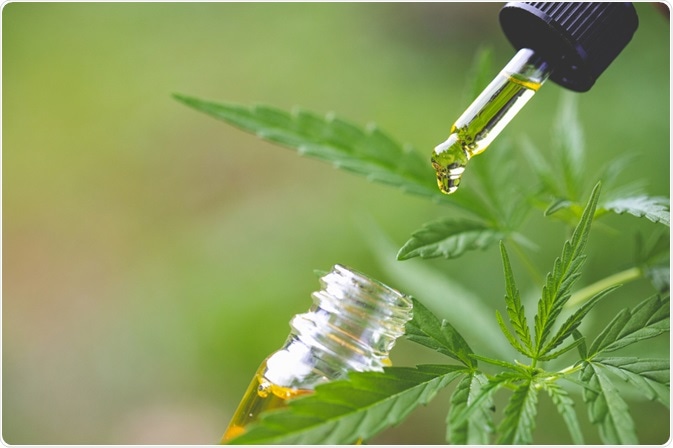Psychoactive substances work by altering the functioning of the nervous system and brain, resulting in changes in moods, perceptions, and/or consciousness when they are introduced into the body. Some people enjoy the effects on their mental state, opting to deliberately induce them for recreational purposes.

Image Credit:Shutterstock/Tinnakorn jorruang
Caffeine and alcohol are the most commonly used psychoactive drugs, but an increase in the desire for greater impact can result in the use of more potent illegal substances, for example, cocaine, cannabis, ecstasy, or LSD.
The desire for such intoxication coupled with the need to avoid prosecution has led to the development of new psychoactive substances (NPS). These are continually being developed to mirror the effects of existing illicit drugs, whilst possessing different chemical structures.
These new psychoactive substances are retailed as safe, legal ways to get high, having major hallucinogenic and stimulatory effects.1
High demand for these chemicals has seen new psychoactive substances being developed at an unprecedented rate. Because the precise chemical composition of new psychoactive substances is commonly unknown, they have the potential to present real challenges to forensic toxicologists and medical staff. Additionally, their easy availability via the internet could pose a significant public health risk.
Synthetic cannabinoids make up approximately half of the substances arriving on the market for the first time in recent years.2
Synthetic cannabinoids
Synthetic cannabinoids are manufactured from man-made chemicals, creating similar effects to the active ingredient found in cannabis - delta-9 tetrahydrocannabinol (THC). Synthetic cannabinoids are sold under a range of different brand names, often housed in brightly colored packaging designed to appeal to younger party-goers.
Synthetic cannabis was initially developed for therapeutic use, but these compounds were quickly employed in smoking herbal mixtures. Small alterations in chemical structure allowed these substances to avoid regulation or inclusion on prohibited substances lists, despite having many of the same effects as ‘real’ cannabis.
A number of these structural differences have led to new compounds that are actually more biologically active than THC, thus posing a higher risk of seizures, psychosis, and coma.3
AB‐PINACA (N‐[(2S)‐1‐Amino‐3‐methyl‐1‐oxobutan‐2‐yl]‐1‐pentyl‐1H‐indazole‐3‐carboxamide) is one such synthetic cannabinoid that binds to human cannabinoid receptors more strongly than THC, becoming more and more popular as a recreational drug.
AB-PINACA
Most AB-PINACA is manufactured covertly before being combined with a plant matrix and sold as a smoking mix aimed at providing recreational highs. AB-PINACA can also be purchased in powdered form as a ‘research chemical’, although AB-PINACA is not recognized for therapeutic use.4
This particular synthetic cannabinoid binds to and activates human cannabinoid receptors up to fourteen times more potently than cannabis’s active component THC. Indicators of use are similar to standard synthetic cannabinoid toxicity and these can include confusion, lethargy, agitation, tachycardia, and hypertension.
It has been possible to detect AB-PINACA and its derivatives in the urine and blood of intoxicated individuals through the use of liquid chromatography−time of flight−mass spectrometry (LC−TOF−MS).5
While analytical methodologies have been validated for the detection of synthetic cannabinoids in human hair (for example, liquid chromatography−tandem mass spectrometry, or LC-MS/MS) there have not yet been any reports of these methodologies being used to detect AB-PINACA in human hair samples.6,7
Hair analysis can be complicated by risks of external contamination, but this remains a useful tool in assessing whether or not an individual has been using legal highs, for example, following driving offences.8
Detection of PINACA in human hair
Patients receiving emergency medical care are hardly ever questioned around the use of legal highs and it is not always possible to detect AB-PINACA in biological samples via conventional toxicological screening. This likely means that health risks associated with its use have been historically under-reported.
It is therefore necessary to be able to rapidly assess the probability of AB-PINACA having been consumed, and, because hair samples are readily available, these may present an ideal means of assessing any potential consumption of AB-PINACA.
A liquid chromatography−tandem mass spectrometry methodology was recently developed for the detection of AB-PINACA in human hair.9 Samples of urine, blood, head hair and pubic hair were taken from an individual injured in a road traffic accident. They were found to be confused, presenting with slow speech and dilated pupils.
Tests for alcohol proved negative, but a bag was discovered in the subject’s pocket containing a white powder and labelled, “AB-PINACA, 10 g, legal research chemical reagent use only”.
The white powder was analyzed using 1H nuclear magnetic resonance via a Bruker AVANCE 300 spectrometer. Urine, blood and hair samples were analyzed via LC–MS/MS. The hair test method was validated for repeatability, linearity, reproducibility and detection and quantitation limits according to guidelines from the Societé Française de Toxicologie Analytique.
No impurities were detected in the AB-PINACA powder itself and its chemical structure matched the structure reported in the literature.
AB‐PINACA was detected in both the urine (<1 ng/mL) and blood (5.7 ng/mL) samples. The low level of AB-PINACA present in urine suggested that it is quickly and completely metabolized once it has entered the body.
Validation of the hair analysis method revealed a limit of detection and a limit of quantification of 0.5 and 1 pg/mg, respectively. It also demonstrated acceptable repeatability, reproducibility and linearity.
Analysis of the hair samples showed an increased concentration of AB‐PINACA in head hair (195 pg/mg) when compared to that of pubic hair (5 pg/mg). The authors suggested that this discrepancy could be due to the contamination of head hair (for example, from the environment, hands or sweat) and the lack of contamination of pubic hair from urine.
References
- Zawilska JB. Int Rev Neurobiol. 2015;120:273-300. doi:10.1016/bs.irn.2015.02.009
- United Nations Office of Drugs and Crime (UNODC). The challenge of new psychoactive substances. Available at https://www.unodc.org/documents/scientific/NPS_2013_SMART.pdf.
- Tai S, Fantegrossi WE. Curr Addict Rep. 2014;1(2):129 136.
- World Health Organization (WHO). AB‐PINACA critical review Report, 39th ECDD, Agenda item 4.4. Geneva, 2017. Available at www.who.int/medicines/access/.../CriticalReview_ABPINACA.pdf.
- Armenian P, et al. Neuropharmacology 2018;134(Pt A):82 91.
- Franz F, et al. Anal Chim Acta. 2018;1006:61‐73.
- Sim J, et al. J Pharm Biomed Anal. 2017;140:162‐168.
- Franz F, et al. Anal Bioanal Chem. 2016;408(13):3445‐3452.
- Arbouche N, et al. Drug Test Anal. 2019;11:610–616. https://onlinelibrary.wiley.com/doi/abs/10.1002/dta.2564
About Bruker BioSpin Group
The Bruker BioSpin Group designs, manufactures, and distributes advanced scientific instruments based on magnetic resonance and preclinical imaging technologies. These include our industry-leading NMR and EPR spectrometers, as well as imaging systems utilizing MRI, PET, SPECT, CT, Optical and MPI modalities. The Group also offers integrated software solutions and automation tools to support digital transformation across research and quality control environments.
Bruker BioSpin’s customers in academic, government, industrial, and pharmaceutical sectors rely on these technologies to gain detailed insights into molecular structure, dynamics, and interactions. Our solutions play a key role in structural biology, drug discovery, disease research, metabolomics, and advanced materials analysis. Recent investments in lab automation, optical imaging, and contract research services further strengthen our ability to support evolving customer needs and enable scientific innovation.
Sponsored Content Policy: News-Medical.net publishes articles and related content that may be derived from sources where we have existing commercial relationships, provided such content adds value to the core editorial ethos of News-Medical.Net which is to educate and inform site visitors interested in medical research, science, medical devices and treatments.